WW2 Air Evacuation
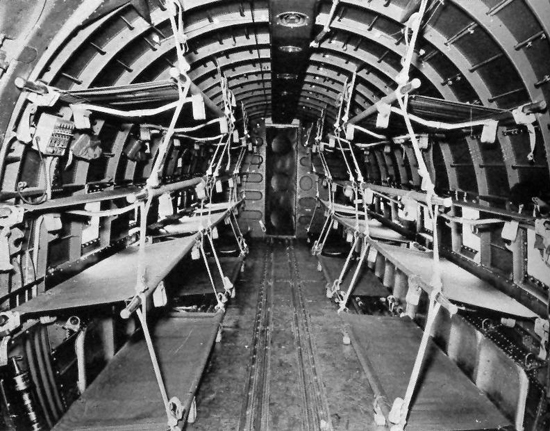
Interior view of C-46 transport plane, it is equipped with webbing strap litter supports.
Background Information:
Wartime evacuation of sick and wounded personnel from overseas Theaters involves problems quite different from those encountered in peacetime because of the volume of traffic and the abnormal transportation conditions! As reported before, the United States Army had not made adequate advance plans, and much had to be done in developing facilities and procedures after the United States entered World War 2 (you are kindly invited to also read our Articles on Hospital Trains and Hospital Ships).
The early measures to provide the necessary means for Hospitalization and Evacuation were taken somewhat haltingly, partly because it was rather difficult to forecast the extent of the needs and partly because of differing opinions regarding the extent to which the necessary means should be used. Procedures evolved only gradually as the result of experience.
The regulations pertaining to the movement of patients were to change in many respects throughout the war, and good coordination between the Army Service Forces (ASF, formerly SOS, Services of Supply), the Chief of Transportation, the Army Air Forces Command, and The Chief Surgeon, were of utmost importance. The general flow of patients from overseas was governed by the War Department (WD) evacuation policy which in effect determined which patients were to be treated in the Theaters, and which were to be treated in the Zone of Interior. Apart from transportation by sea, the number of patients transported by air would gradually increase as more means became available. Air Evacuation had its advantage; it was speedy and highly desirable for the critically wounded for whom proper treatment could not be furnished in the Theaters. The Chief of Transportation however had no responsibility for patients evacuated by air, but he worked in close coordination with the US Air Transport Command in regard to plans and procedures to be utilized.
World War 2:
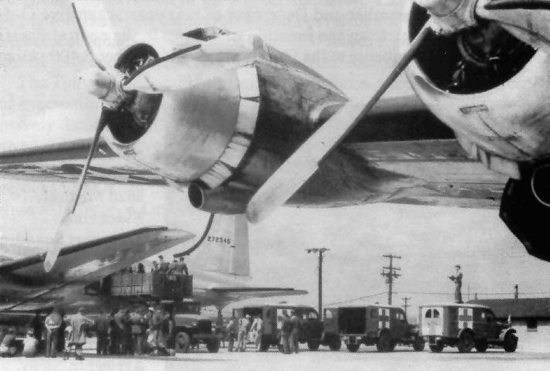
C-54 Skymasters, four-engine cargo planes, evacuated thousands of combat casualties from Great Britain to the Zone of Interior.
The US Armed Forces had their first large-scale experience with Air Evacuation during WW2. Because incapacitating wounds frequently occurred in areas remote from available medical facilities, providing care to soldiers and airmen often required evacuation by air! In fact, informal Air Evacuation operations began in 1942 in the Pacific Theater and in Asia. Most sea and land routes in the CBI Theater and the Southwest Pacific region inhibited rapid medical evacuation. Cargo and Troop Carrier planes returning empty from the front lines were often the ONLY swift means of evacuation, and transported medical patients to General Hospitals in New Caledonia, the New Hebrides, and Australia.
Other overseas Theaters would also inaugurate a successful method of Air Evacuation, thereby further contributing to improved methods in organization, equipment, and training.
According to T/O 8-455 dated November 19, 1941 a Medical Air Ambulance Squadron (later designated Medical Air Evacuation Transport Squadron) consisted of one Squadron Headquarters, one Ambulance Section (single-engine transport plane), and two Ambulance Sections, (bi-engine transport planes). Total personnel included 45 Commissioned Officers, and 218 Enlisted, with a number of vehicles, such as 10 Cross-Country Ambulances, 4 Five-Passenger Sedan Cars, 7 ¼-Ton Trucks, and 4 1 ½-Ton Cargo Trucks. When necessary, suitable light aircraft capable of operating from small fields or airstrips were to be substituted in the bi-engine transport planes, on the basis of 18 single-engine airplanes for 12 bi-engine planes.
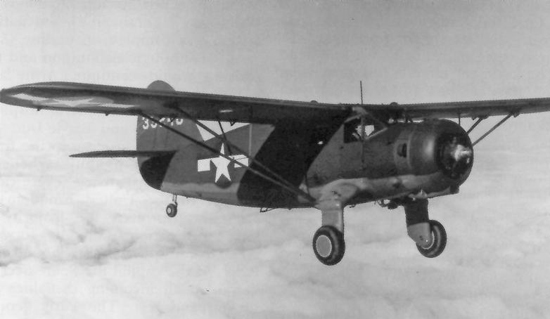
Picture of UC-64, single engine, high-wing monoplane, designed for observation and liaison, but succesfully introduced for emergency air evacuation of patients. Capacity: three litter patients; station: Le Bourget Airfield; unit: 320th Squadron, 302d Transport Wing.
The MAETS was generally assigned to one of several commands of the United States Army Air Forces for the purpose of providing Medical Department personnel to Troop Carrier and Air Transport units utilized in air evacuation of sick and wounded. By late 1944, T/O 8-477 described the Squadron as consisting of one Squadron Headquarters and four identical Evacuation Flights. Each Flight was normally composed of 1 Medical Officer, 6 Army Nurses, and 8 Enlisted Men. It could be further subdivided into 1 Classification Section (Flight Surgeon, Clerk, and Supply Corporal) and 6 Evacuation Teams (Nurse, Medical Technician). The majority of vehicles were light Trucks and Trailers, including a Water Trailer.
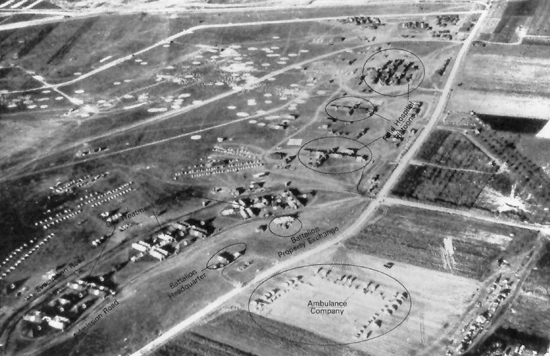
Installation of Air Holding Unit at Toul, France, supporting the Third US Army. They consisted of elements of the 93d Medical Gas Treatment Battalion, the 425th Medical Battalion, and two Field Hospitals. September 1944.
During and after ‘Operation Torch’, the invasion of North Africa, (Algeria-French Morocco Campaign 8 Nov 42 > 11 Nov 42) hospitalization and evacuation of Task Force casualties remained the responsibility of the expeditionary surgeons until the medical section of the Allied Force Headquarters was securely established. Evacuation of critical cases from the Western Task Force at the time was by Troop Transport to the United States, while casualties from the Center and Eastern Task Forces took place by British Hospital Ships to the United Kingdom. It was only during the early phases of the Tunisian Campaign (17 Nov 42 > 13 May 43) that more patients were to be evacuated by air, utilizing medical facilities and aircraft furnished by the Twelfth United States Air Force. Casualties were now being flown out, but the operation was still informal and infrequent – with time it would quickly prove its worth!
While evacuation from the Tunisian battlefields went mainly by ambulance and rail, the presence of USAAF installations (primarily serving Squadron Aid Stations), contributed to the beginning of air evacuation procedures. Overcome by the magnitude of battle losses, and the high number of casualties, the Medical Department, with the help of the Army Air Forces, could now fly patients direct by air to fixed Hospitals in Algiers and Oran (Algeria).
The first comprehensive plans for Air Evacuation were put into effect after formal discussions in Algiers on January 12, 1943 between the Twelfth US Air Force Chief Surgeon Colonel Elvins (51st Troop Carrier Wing) and Brigadier General Albert W. Kenner. The II Corps Surgeon established Holding Hospitals near forward airfields operated by the Air Force. Planes used were C-47s rigged with litter racks to hold 18 or 20 non-ambulatory patients and staffed by personnel of a Medical Air Evacuation Transport Squadron. Evacuation crews consisted of Medical Technicians and Flight Nurses, and Flight Surgeons often accompanied critical patients. The planes carried an Evacuation Kit consisting of blood plasma, oxygen, morphine, portable heaters, first-aid medicine, hypodermic apparatus, blanket sets, splints, a Chest MD #4, and approximately 432 litters. There were no regular schedules, since the planes were used for evacuation only on their return flights (after discharging cargo and personnel in the combat zone). Although these planes were not marked with the Geneva Cross and flew at low altitudes, there were no enemy attacks. Between January 16 and May 23, 1943, a total of 4,806 patients (966 sitting + 3,840 litter cases) were evacuated by air to Algiers and Oran (informal air evacuation before that date is estimated at 887 patients).
The experience in North Africa gave both ground and air Surgeons some idea of the immense capabilities of Air Evacuation, which continued to be increasingly used through the rest of World War 2…
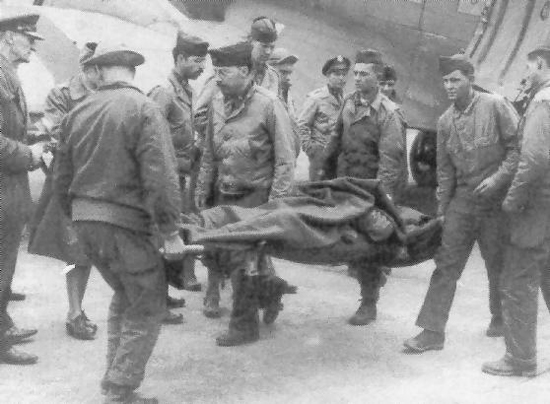
Aeromedical evacuation personnel bringing in casualties from the Normandy invasion beaches, June 1944.
Hospitalization and evacuation in the Sicily Campaign (9 Jul 43 > 17 Aug 43) showed marked improvement over practices in North Africa and Tunisia in particular. Critical, but transportable cases were sent directly to Evacuation Hospitals, where they were held for additional treatment, or evacuated to the North African ComZ, according to circumstances. Overcrowded hospital facilities and the strain placed upon medical units, who not only had to care for American troops, Allied patients, and captured enemy personnel, but also for a large number of Italian civilians who had no other means of medical treatment, made evacuation out of Sicily necessary! The Seventh United States Army Surgeon arranged for immediate evacuation from the island by Hospital Ships and Carriers, while arrangements were made with the North African Air Force Troop Carrier Command to handle part of the evacuation by air from airfields around Gela and Licata, starting July 14, from Agrigento, starting July 23, from Palermo, starting July 27, and from Termini, starting August 5, 1943. Between July 10 and August 10, 1943, a total of 5,967 patients were evacuated by air to Mateur and Tunis. Air evacuation from Sicily followed the basic patterns developed in Tunisia, but was more highly organized. It must be noted, that only a handful of critical patients were evacuated by air to the United States. In fact over 20,000 US Army patients were evacuated from N. Africa to the ZI by American Hospital Ships and Troop Transports (Jan > Dec 43). The total percentage of medical patients evacuated by air during 1943 only represented 4.5%.
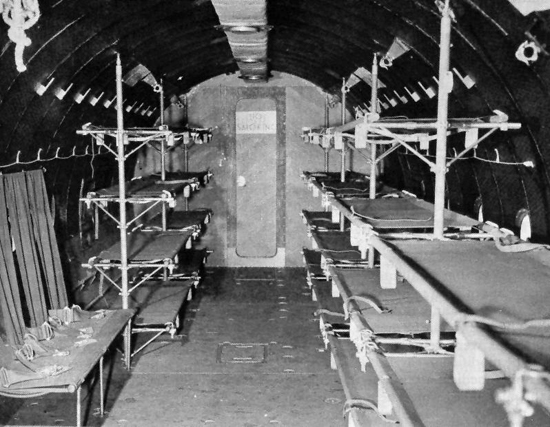
Interior view of C-54 transport plane, this version is equipped with metal litter supports to make quartering casualties swift and easy.
With the landings at Salerno on September 9, 1943, began ‘Operation Avalanche’, the invasion of the Italian mainland. Since the Tunisian and southern Italian campaigns supported the principle of air evacuation by the Twelfth and Ninth US Air Forces, the method now proved suitable for every type of patient, except those in shock. Moreover this method of evacuation was available and suitable day and night and demonstrated enough safety to be increased. During the Italian Campaigns (Naples-Foggia 9 Sep 43 > 21 Jan 44 – Anzio 22 Jan 44 > 24 May 44 – Rome-Arno 22 Jan 44 > 9 Sep 44 – North Apennines 10 Sep 44 > 4 Apr 45 – Po Valley 5 Apr 45 > 8 May 45), Fifth US Army patients were moved as rapidly as possible to fixed hospitals in North Africa and in the developing Communications Zone area around Naples. All evacuation out of the combat zone was to Africa, by sea from the Salerno Beachhead, and by air from Naples. Between September 9, 1943 and January 21, 1944, 19,048 patients were evacuated by air from Italy to North Africa.
Then came ‘Operation Shingle, the landing at Anzio on January 22, 1944. During the build-up, with casualties mounting, and troops still blocked on the beachhead (until the breakout on May 23), immediate evacuation was either by LST, or if possible by Hospital Ship. Air evacuation proved impossible, before the junction of the Allied Armies and the dissolution of the beachhead itself. Between January 22 and May 22, 1944, 23,860 US and 9,203 British casualties were evacuated safely from the Anzio beachhead.
Both the 802d and 807th Medical Air Evacuation Transport Squadrons (MAETS) were heavily involved in aeromedical evacuation. The first flight from the Nettuno airstrip was made on May 26, 1944, while additional holding units for air evacuation were to operate at various points, flying casualties to fixed hospitals in Naples and Caserta. Between May 26 and August 31, 1944, a total of 33,793 patients were evacuated by air from Fifth Army Hospitals.
Throughout the Volturno and Winter Line Campaign, air evacuation flights operated from Naples and Foggia, with destination the Tunis-Bizerte area, while Hospital Ships were routed to Oran. Direct evacuation by air to the Zone of Interior began only out of Casablanca on July 3 and out of Naples on July 19, 1944.
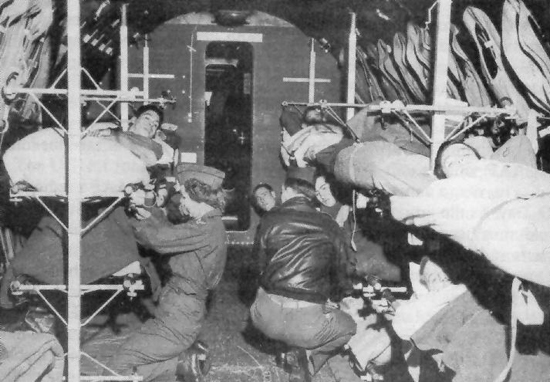
1st Lt Margaret Murphy, Flight Nurse and another crew member adjust traveling litters aboard a C-54 Skymaster, returning patients to the United States’ Zone of Interior. A trip usually took 24-hours, including a single stop-over to change crews, refuel, and feed the patients …
In the European Theater of Operations, a small but growing number of medical patients now crossed the Atlantic by air. Following categories of priority patients were established for this method of evacuation: emergency cases without further treatment locally available – men whose evacuation was deemed a military necessity – men who required prolonged hospital and convalescent care. Most patients in these categories were transferred from General Hospitals to the Transatlantic Military Air Terminal at Prestwick, Scotland, where USAAF and SOS personnel loaded the evacuees on C-54s for the flight to the United States. In the course of 1943, USAAF Medical Air Evacuation Transport Squadrons began arriving in the United Kingdom to formally run the operations (with the 811th MAETS operating out of Prestwick).Additional units were organized and would serve overseas, including the Pacific and the China-Burma-India Theaters. They involved the 803d – 810th – 813th – 815th – 816th – 817th – 819th – 820th – 821st – 823d – 824th – 830th MAETS …
Up to the end of 1943, very few ETO sick and wounded were evacuated by plane to the ZI. Air evacuation only began expanding and increasing in early 1944, after having proved its worth in carrying patients in the Mediterranean and Pacific Theaters. In the European Theater, the ATC had more planes and medical personnel available, and in view of the planned D-Day Invasion preparations, it began enlarging medical facilities at intermediate stations on its transatlantic routes, in view of possible mass patient movements. Invasion plans directed the Ninth Air Force to equip all its transports with suitable litter racks, give medical care to all casualties in flight, give emergency medical care at airfields, deliver casualties to airbases in great Britain, and try to use all aircraft returning from continental forward areas for patient evacuation. Air evacuation, however, would only supplement evacuation by road, rail, and sea, and would depend on the degree of air superiority, the tactical situation, and the weather.
During D-Day and the days immediately thereafter, almost 80% of the casualties were evacuated by sea! Cross-Channel casualty flights began on June 10, 1944 and proved both efficient and beneficial for many patients! They grew so rapidly in volume, that between June 10 and July 31, 1944, 25,959 American wounded had been returned from France by plane (this accounted for almost 33% of all US casualties). It was the IX Troop Carrier Command which furnished the necessary C-47 transports to pick up the patients at pre-designated airstrips in Normandy. Most air-evacuated casualties landed at Ramsbury and Membury airfields (Southern Base Section), controlled by the Ninth United States Air Force. As the logistical efficiency and medical advantages of air evacuation became apparent, the Medical Department and the Army Air Forces opened additional receiving facilities at other British airfields, close to General Hospitals. With extra bases available, the medical service had the capacity to handle 6,000 air-evacuated casualties per day! The limited air evacuation expansion was inadequate to meet all medical needs, and by late September of 1944, a backlog of almost 7,000 patients on the continent prompted the Theater Surgeon to resubmit proposals for a dedicated air evacuation force, which was again rejected. To supplement medical transport facilities, twenty small UC-64 monoplanes were requisitioned and dedicated to medical missions (320th Squadron, based at Le Bourget) primarily resupplying forward areas with blood and other critical medical items. Some were even equipped with three litters each, for evacuating patients. Those light planes eventually managed to evacuate 1,168 patients, transport 30,000 pints of blood, and about 460 tons of other medical supplies between September 23 and December 29, 1944.
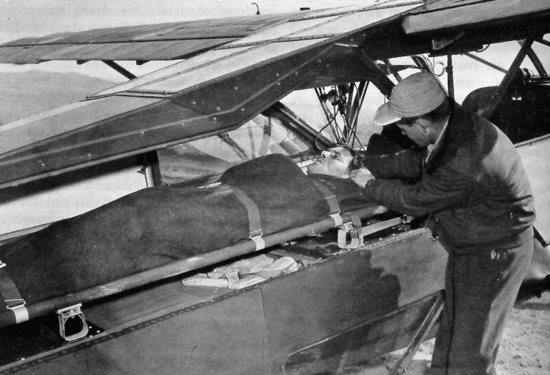
Loading and strapping a patient on an L-5 single engine, light observation and liaison plane. Aeromedical evacuation of single or small numbers of patients often took place in UC-64 and L-5 airplanes.
In 1944, 18.2% of all Army casualties were evacuated by plane. The expansion of the Communications Zone, and the rapid advance of the Allied Armies precipitated the installation of Air Holding Units, consisting of Field Hospitals and other medical facilities in order to send off patients by air (lack of trucks, long evacuation routes). The widening gap between combat forces and ComZ rear medical treatment and evacuation still clustered near the Normandy beaches and in England held up normal evacuation by road or by train. Between August and September 1944, C-47s carried about 54,000 patients to Britain, and 6,300 to various destinations in France. Although the European Theatre used Air Evacuation more than other Theatres, especially from forward areas, the majority of patients still travelled by Hospital (or Transport) Ship, especially for evacuation to the Zone of Interior. There were simply not enough transport aircraft, or suitable patients to justify a more significant use of Air Evacuation to the United States. The end of the war in Europe, and the enhanced military operations in the Pacific, did increase medical air evacuation, notwithstanding the lack of priority for evacuating patients (as opposed to supply of military personnel and materiel), and in 1945, the number of patients evacuated by air reached 22.5%.
Figures from the ADSEC, ComZ, 1944 Annual Report, indicate following trends in evacuation from the continent: SEA June 1944 = 16,400, AIR June 1944 = 5,730 – SEA July 1944 = 37,229, AIR July 1944 = 27,942 – SEA August 1944 = 44,218, AIR August 1944 = 49,415, RAIL August 1944 = 1,282 – SEA September 1944 = 0, AIR September 1944 = 61,744, RAIL September 1944 = 5,174 – SEA October 1944 = 0, AIR October 1944 = 71,899, RAIL October 1944 = 27,393
Flying Nurses: in 1944, over 6,500 Nurses were on duty with the AAF. Of this, 500 were Flight Nurses serving throughout the world whenever wounded needed to be evacuated by plane. When assigned to the US Army Air Forces, Army Nurses were sent to 11 different AAF Training Centers for 4 weeks of military training and physical conditioning, before being sent to the various USAAF Station Hospitals throughout the Zone of Interior.
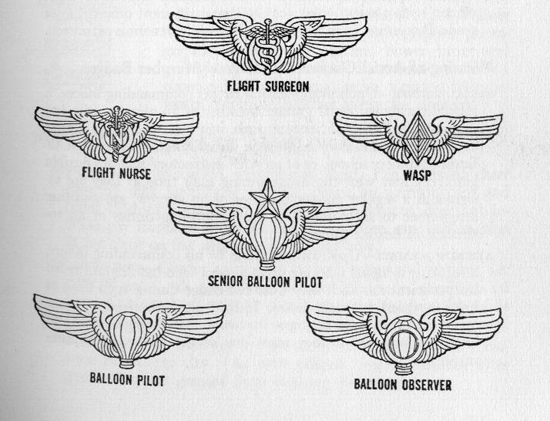
Flight Nurse wings
In June 1942, the War Department established the Air Transport Command (ATC) to move equipment, cargo, and personnel between the various Theaters. In September, the command began to assign high-priority to sick and wounded patients returning to the ZI. As new and more powerful C-54 ‘Skymasters’ soon became available, the first regular scheduled medical evacuation flights from the United Kingdom to the United States got under way in the summer of 1943. Similar routes were set up from North Africa.
In the Pacific Theaters the ATC moved a monthly average of 21 patients from Pacific regions to the ZI, starting March 1943. In fact, large-scale evacuation would not begin until late November-December 1943, when five C-54s evacuated casualties from the Invasion of Tarawa. The Command would later move 3,260 patients to the United States and 5,400 cases between Theaters during the same year. By September 1945, ATC evacuations would account for approximately 5% of the total 1.34 million air evacuations made during WW2.
After 6 months’ duty in an AAF Hospital, members of the ANC were eligible to apply for Flight Nurse training. If they met all the demands, the Nurses were sent to the ‘School of Air Evacuation’, Bowman Field, Kentucky. Here they underwent 8 weeks of academic, professional, military and physical training to prepare them for the strenuous duties ahead. Upon graduation, they were rated Flight Nurses and were permitted to wear special gold Combat Observer wings with the A.N.C. insignia superimposed. The first Flight Nurses arrived in the Sicilian and Italian Theaters as soon as it was possible to send transport planes to the front for evacuating the wounded.
